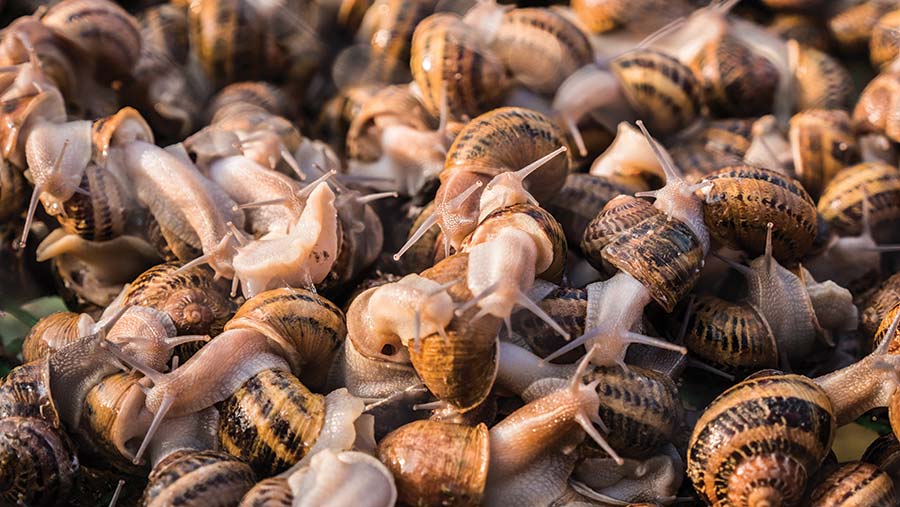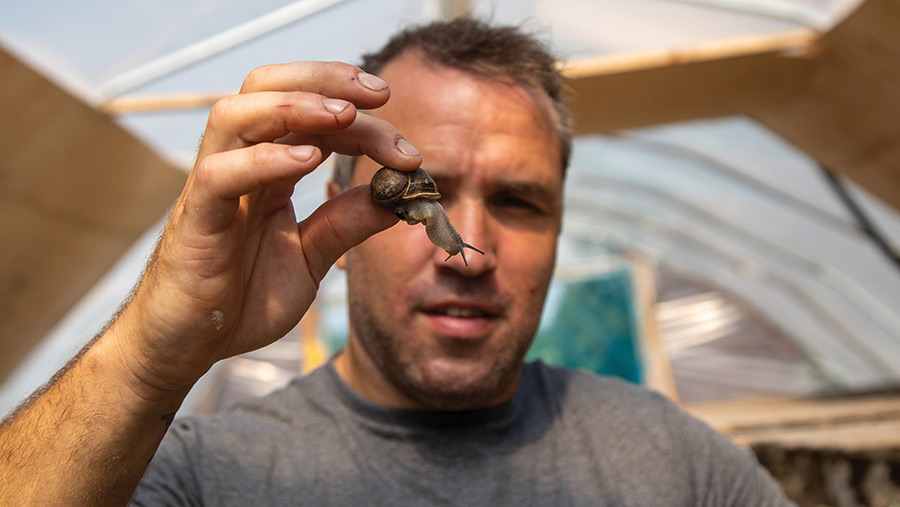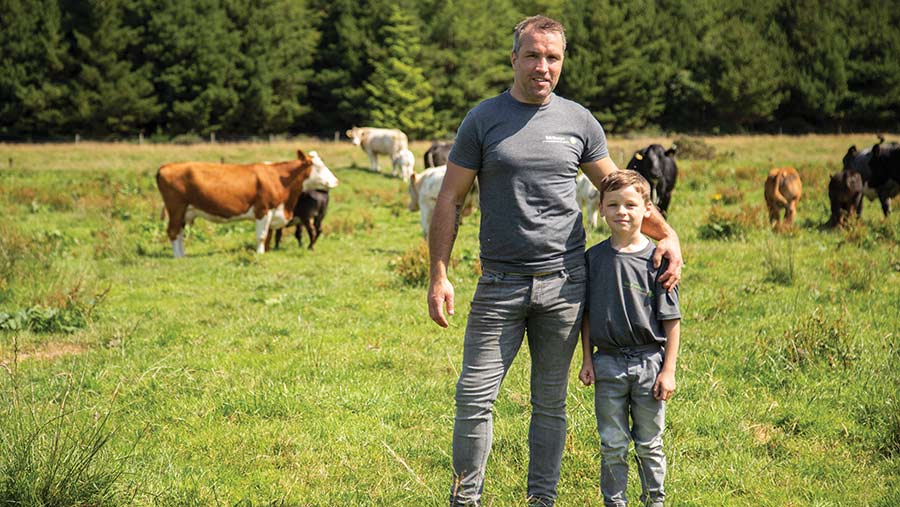Why an Irish beef producer diversified into snails
 Helix Aspersa Muller snails © Stock Media Production/Adobe Stock
Helix Aspersa Muller snails © Stock Media Production/Adobe Stock Snails may not be a regular choice in British and Irish diets, but in mainland Europe they remain popular as an everyday staple and delicacy.
Yet, in Ireland, snail farming (also known as heliciculture) has seen increased interest from landowners in the past decade, as rising temperatures in European growing areas make snail production more challenging.
See also: Wildflower seed diversification gives arable tenants security
Suckler producer and snail farmer Peter Monaghan, of Maghera, County Cavan, wanted to farm from a young age.
But with only 10ha (25 acres) of land, he knew he needed something that would not take up much room and suit Ireland’s temperate climate.
While working in the transport industry for 15 years, Peter also ran a 25-head suckler herd of Limousin and Belgian Blue cows, producing top-quality weanlings.
He knew beef production would not sustain him full-time, so he set about researching diversification options.

Peter Monaghan © Inis Escargots
After much fact-finding, he found that snail farming could work in Maghera’s mild and wet conditions, did not require much land and could be run single-handedly. “It ticked all the boxes,” he says.
It was also a relatively low-cost system to establish, especially when the infrastructure could be erected in-house, with initial set-up costs of a half-acre site in the region of £10,000 – including the first crop of snails.
Getting started
In 2017, Peter set up Inis Escargot with his first batch of juvenile Irish snails. He opted for the species Helix Aspersa Muller, one of the most popular eating snails in Europe.
He now rears, fattens, finishes and exports more than three million snails a year, with building work currently under way for a processing plant on the farm.
“The more I researched, the more I realised snail farming was the right option for me,” he says. “However, I came across so many different methods of snail farming, I had to choose something right for me and my farm.”
The two main types of snail farming adopted in Ireland are the semi-intensive method, which provides a controlled environment for breeding and rearing, and the more extensive method, which has fewer inputs and works with the natural cycle of the snails.
Peter opted for the semi-intensive route to help guarantee output from his farm.
The operation is run separately from the beef cattle, with 0.8ha (two acres) of land set aside for snail production.
Snail setup
Regardless of operation type, it is vital to have secure, pest-free pens positioned on the correct ground.
Pens should be sited on well-drained land with a pH of 6.5-7.5.
Once fields are selected, electric mesh perimeter fencing is erected to ensure pests (rats and mice) stay out, with netting to cover the pens for bird control. This should consist of galvanised mesh along with corrugated sheeting.
The ground must also be prepared so the pens are ridged in the centre to aid drainage. In both situations, separate pens are used for breeding and fattening snails.
About 700 raised wooden boards measuring 1.2×0.6m, angled off the ground and spread across the pen, provide shelter from the sun, and snails are fed on top.
Crops are planted in the pens to provide cover and food for the snails. Peter uses forage rape for cover.
“Laying paddocks out correctly and planting a strong crop is critical. Snails don’t like weeds, so if you have a strong forage rape crop, this will help suppress weeds.
“However, this year, we struggled due to the weather, so we had to go in and manually pull the weeds out, as you can’t go in with the mower. Managing paddocks is key,” he says.
Stocking rates and yields
In semi-intensive systems, the typical production cycle consists of breeding between January and March, which Peter now does in a specialised 93sq m breeding room.
Juvenile snails are reared in a polytunnel, and sprinklers are turned on between 8-9pm daily to keep conditions moist.
They are housed under cover until frosts have passed in May before being let out.
Snails are stocked at a rate of 200-300/sq m, something he says is key to a successful site. “If you overpopulate a paddock, it will stunt growth.”
They are fed a special high-protein, high-calcium meal each day, starting at about 5kg a night for the group at juvenile level, to 100kg of feed at semi-fattening stage.
To feed his 1-1.2 million snails at peak in August, Peter is using about 150kg of feed a day.
Snails are usually ready to harvest by September/October when their shells are completely hard. At this stage, they will weigh 10-12g; any snails bigger than this are kept for breeding.
In his first year, Peter produced more than 4t of snails off the farm. He is now averaging 8-10t a year.
“For farmers setting out, it’s important to be realistic about how much you can produce off the farm in the first year,” he says.

With limited land available, Peter Monaghan settled on snails as a compact, efficient diversification © Inis Escargot
Breeding snails
In his second year, he decided to breed his own snails and set up a temperature- and humidity-controlled breeding room, but admits it was initially a disaster.
“After more research, I fine-tuned the breeding and changed the lighting and heating. After that, it started to go quite well.”
In his third year, Peter kept back 50% of his own snails for breeding. He achieved a lower mortality rate compared with bought-in stock, so now he breeds all his own.
Snails are hermaphrodites (with both male and female reproductive organs) and breed by mating with another snail before they lay eggs. They usually start mating when they are 5-6 months old.
“Breeding snails is labour-intensive as you have to pick eggs daily from January to March and wash the room out every three days to get the results,” Peter says.
“Every minute you put in with the snails, you get back with your return. That’s not something you get with the cattle.
“You also know the price you are going to receive from your sales in advance,” he says.
Peter now sells breeding stock to other snail farmers, by keeping back 900kg of his best snails for replacement breeding, which are picked in early September.
He also provides training and advice on system setup for individuals interested in diversifying into snails.
Marketing produce
Marketing of the end product is also key. Peter sends most of his snails to mainland Europe but is also selling a small proportion into high-end restaurants in the UK and Ireland.
He was recently granted planning permission to build an on-site processing plant, which will enable him to produce a range of products including beauty creams using the mucin (slime) produced by snails.
Recent research has found that snail mucin could potentially help protect against melanoma (skin cancer), so it is a product he believes will increase in popularity as more is learnt about it.
“Snail farming is a profitable enterprise if you have the right conditions and route to market.
“It’s a way of life, but it is allowing me to see the kids every day, and there’s no comparison in profitability compared with beef production.”
